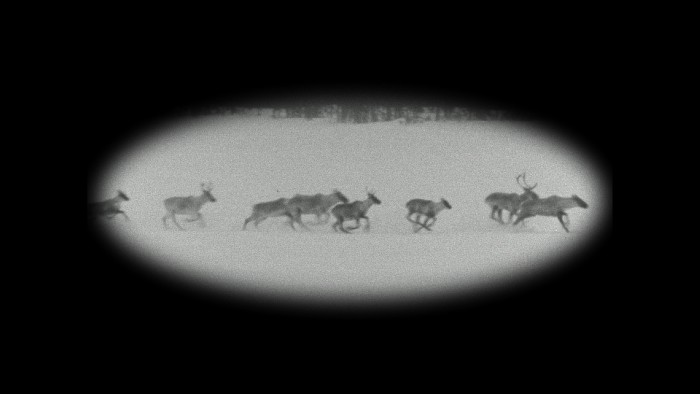Kushapetshekan / Kosapitcikan—A Glimpse Into The Other World, the Montreal Museum of Fine Arts’ (MMFA) newest installation, would be easy to miss were it not for the strange and otherworldly sounds emanating from the dark room at the far end of the museum’s permanent collection of contemporary art. Whether intentional or the result of a lack of space, the fact that the installation was hidden spoke volumes. On display until Feb. 4, the exhibition is part of Woman. Artist. Indigenous., the MMFA’s season-long cycle highlighting the work of female indigenous artists.
The exhibition promotes itself as an “immersive, spiritual experience,” that “[transposes] the Innu and Atikamekw idea behind the words kushapetshekan and kosapitcikan, kept secret by those First Nations peoples—without, nonetheless, entirely revealing it.” Artists Eruoma Awashish, Meky Ottawa (both of Atikamekw descent) and Jani Bellefleur-Kaltush (who hails from the small Innu community of Nutashkuan.)
"Through the work, the artists share an element of their culture in their own way, while leaving a way open for interpretation,” the museum advertised.
The foreboding pitch-black room housed nothing but a tall cylindrical mechanism with a projector displaying a film positioned above it. A sheet of canvas wrapped around six sturdy poles, creating a kind of hexagonal cave with one panel missing.
Viewers were presented with a choice: Stand outside the device and watch the film from afar to see the complete image, or step inside the tiny claustrophobic space and see it from one angle only. I watched the film (roughly three minutes in length) twice from both positions and each time I noticed something new.
The bizarre, non-sequitur shots changed quickly and without warning—deer being chased by wolves across the screen, followed by a close-up of a young girl staring into the dancing flames of a bonfire. A continuous line drawing of a buffalo bounced comically around the space, in time with the sinister music. At one point, the imprint of a face and two hands appeared onscreen—accompanied by the sounds of heavy breathing, as if someone was standing outside the installation, pressed against the material.
During the minutes I spent inside that shadowy, ominous room, half a dozen people came and went. Some sidled up beside me inside the cramped space, shoulder to shoulder or back to back in the silence. Some giggled nervously while others contemplated quietly.
Stepping out of the dark room back into the bright, minimalist display of contemporary art does indeed give the impression of having returned from another world entirely. Everything about the piece—from its bizarre, inhospitable location to its strange and fragmentary images—leaves the viewer feeling like they’ve missed something. Appropriately enough, the installation offers merely a glimpse into the creators’ minds.
According to the artists, the creative approach taken during production was “rooted in decolonization.” By forcing viewers into a bizarre and alien experience, the piece forcibly dismantles the colonial instinct to try and define things we don’t relate to. Instead, the viewer has no choice but to accept that the bizarre imagery is simply beyond the scope of their understanding—that the artists gave us only a portion of the story on purpose. The feeling of disorientation is as much a part of the experience as the film—viewers step into the dark and stay there, long after they’ve exited the museum.
The installation appears courtesy of the National Film Board of Canada’s (NFB) three-year plan to increase awareness of indigenous art. The NFB is dedicating at least 15% per cent of funds to producing future indigenous-led projects.









